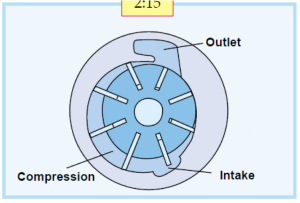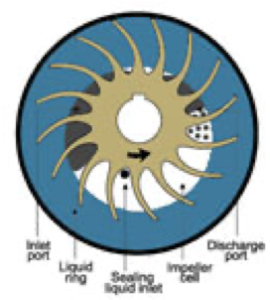Part 3 – Rotary Compressors
Rotary Air Compressors
Rotary air compressors have variable speed operation. They are capable of providing delivery pressures up to about 1500 kPa. Free-air capacities of this type of compressor can reach 1500 m3 per minute.
rotary air compressors can be divided into four types:
|
1 . Sliding Vane Longitudinal vanes slide radially in a rotor mounted eccentrically in a casing |
|
2. Roots or lobe Two or more lobed impellers revolve within a casing |
| 3. Screw Type
Two intermeshing screws rotate in a casing |
| 4. Liquid Sealed
Liquid displaces air within a rotating element |
Video: Mattei Rotary Vane Air Compressor Principle
Watch the video “Mattei rotary vane air compressor principle” [5:00].
1. Sliding Vane Compressors

Discharge air pressures up to about 400 kPa for single-stage machines. This can be up to about 1000 kPa for two-stage units. Capacities up to 170 m3 per min. Prime Mover sizes range from 100 W to 375 kW. Operate at speeds from 250 r/min to 3000 r/min. Air Cooling, internal water or oil cooling carry away the heat of compression
Rotary Vane Compressor:
Advantages
Disadvantages
|
Rotary Air Compressors
In some sliding vane models, the vanes contact two wear rings or liners that are concentric with the casing and free to rotate within it. These rings are perforated to allow the air to enter and leave spaces between the vanes.
Advantages
- Wear on the outer edges of the blades is considerably reduced.
- Power required to drive the compressor is also reduced, due to a decrease in frictional losses.
- Permits higher operating speeds and consequently a greater output of compressed air for a given power input.
2. Lobe-type Compressors
Air cooled positive displacement compressors. They are built for capacities up to 1500 m3/min. For discharge pressures in one stage up to 100 kPa. Discharge pressures up to about 200 kPa can be reached in two stages. They operate at speeds of operation up to about 1750 r/min. Incorporate a relief valve in the delivery line upstream of the block valve.
Rotors or impellers revolve without touching each other and without friction on the casing. This means no wear occurs and no need for internal lubrication. The air or gas passing through the machine consequently remains dry and free of oil.
3. Screw Type Compressors
One lobe-flute space reaches the outlet before the previous space has completely emptied ensuring continuous compression and pulse-free air delivery. The air flows through a screw compressor in four stages:
- Air is drawn in through the compressor inlet into the interlobe space.
- Further rotation seals the space off from the inlet.
- The male lobe occupies more space in the female flute and compresses the air.
- Continued rotation brings the compressed air to the outlet port shown by the dotted lines.
- Tandem screw compressor designs have a power advantage over equivalent single-stage compressors.
Dividing the compression over two stages reduces the compression for each stage. Reduces internal leakage losses and can reduce required power by 11-13%. The two stage compressor is larger and more expensive to purchase.

Oil Lubricated Screw Compressor Element:
- Male rotor has fewer lobes than the female has flutes.
- The two rotors trap and compress the air until it passes the discharge outlet.
- Power is usually applied to the male rotor.
Activity: Images of One and Two Stage Screw Compressors
Click the arrows to view a one and two stage screw compressor
Air and Gas Compression Advantages and Disadvantages
Advantages |
Disadvantages |
|
|
4. Liquid Sealed
Video:
Watch the video
The size ranges where 15 to 150 kW drivers are used to compress gases to about 1500 kPa. A multi-bladed rotor revolves in an elliptical casing partly filled with a liquid. Liquids used include water, acid, alkali solvent, or refrigerant depending upon the gas being compressed. When air is compressed, water is normally used.
Liquid Ring Compressor


Advantages are they produce clean air free from dust, heat or oil. Essentially, the liquid seal removes all contaminants and no internal parts requiring lubrication so oil is not entrained in the discharge. An aftercooler is not required.
